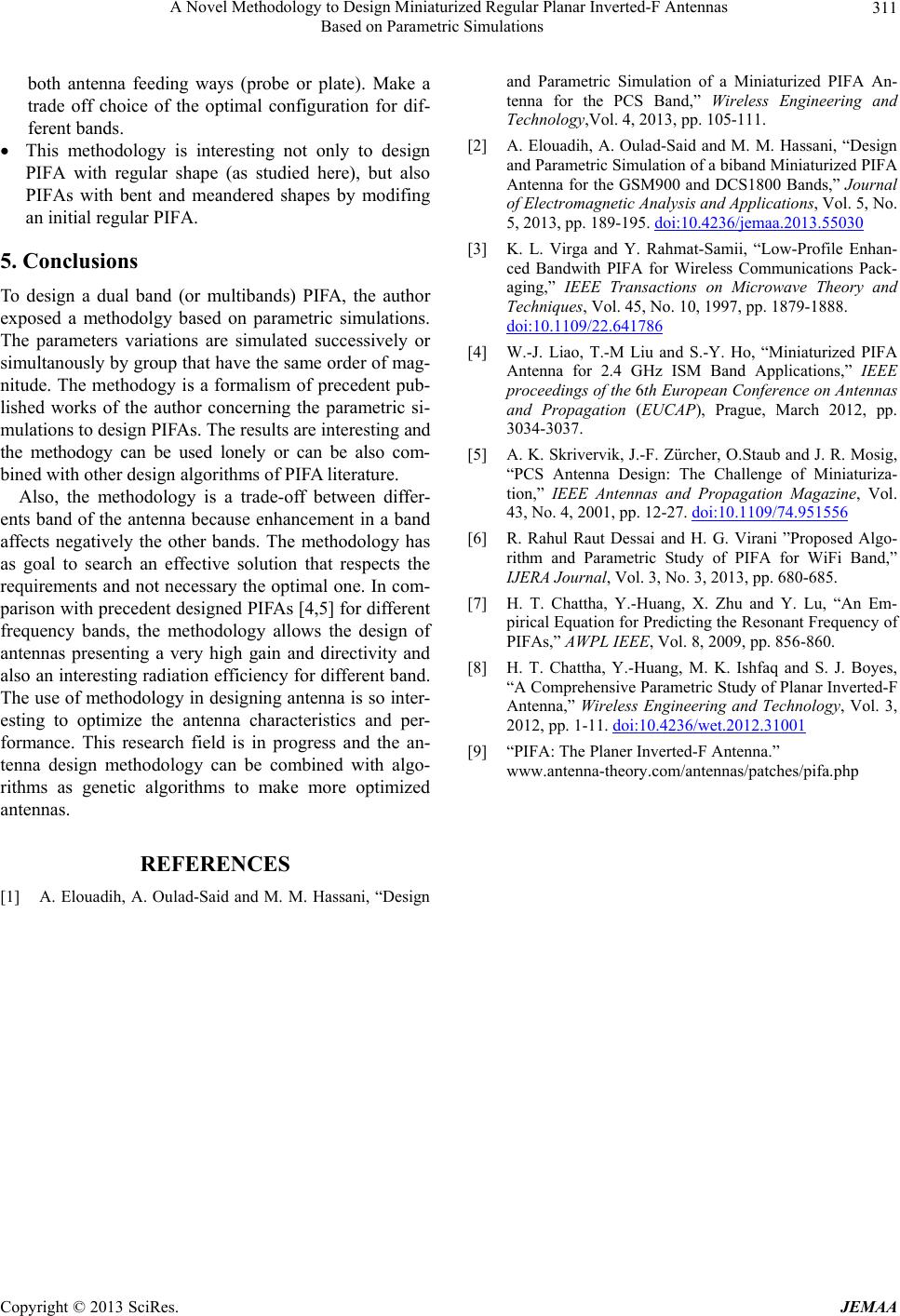
A Novel Methodology to Design Miniaturized Regular Planar Inverted-F Antennas
Based on Parametric Simulations
311
both antenna feeding ways (probe or plate). Make a
trade off choice of the optimal configuration for dif-
ferent bands.
This methodology is interesting not only to design
PIFA with regular shape (as studied here), but also
PIFAs with bent and meandered shapes by modifing
an initial regular PIFA.
5. Conclusions
To design a dual band (or multibands) PIFA, the author
exposed a methodolgy based on parametric simulations.
The parameters variations are simulated successively or
simultanously by group that have the same order of mag-
nitude. The methodogy is a formalism of precedent pub-
lished works of the author concerning the parametric si-
mulations to design PIFAs. The results are interesting and
the methodogy can be used lonely or can be also com-
bined with other design algorithms of PIFA literature.
Also, the methodology is a trade-off between differ-
ents band of the antenna because enhancement in a band
affects negatively the other bands. The methodology has
as goal to search an effective solution that respects the
requirements and not necessary the optimal one. In com-
parison with precedent designed PIFAs [4,5] for different
frequency bands, the methodology allows the design of
antennas presenting a very high gain and directivity and
also an interesting radiation efficiency for different band.
The use of methodology in designing antenna is so inter-
esting to optimize the antenna characteristics and per-
formance. This research field is in progress and the an-
tenna design methodology can be combined with algo-
rithms as genetic algorithms to make more optimized
antennas.
REFERENCES
[1] A. Elouadih, A. Oulad-Said and M. M. Hassani, “Design
and Parametric Simulation of a Miniaturized PIFA An-
tenna for the PCS Band,” Wireless Engineering and
Technology,Vol. 4, 2013, pp. 105-111.
[2] A. Elouadih, A. Oulad-Said and M. M. Hassani, “Design
and Parametric Simulation of a biband Miniaturized PIFA
Antenna for the GSM900 and DCS1800 Bands,” Journal
of Electromagnetic Analysis and Applications, Vol. 5, No.
5, 2013, pp. 189-195. doi:10.4236/jemaa.2013.55030
[3] K. L. Virga and Y. Rahmat-Samii, “Low-Profile Enhan-
ced Bandwith PIFA for Wireless Communications Pack-
aging,” IEEE Transactions on Microwave Theory and
Techniques, Vol. 45, No. 10, 1997, pp. 1879-1888.
doi:10.1109/22.641786
[4] W.-J. Liao, T.-M Liu and S.-Y. Ho, “Miniaturized PIFA
Antenna for 2.4 GHz ISM Band Applications,” IEEE
proceedings of the 6th European Conference on Antennas
and Propagation (EUCAP), Prague, March 2012, pp.
3034-3037.
[5] A. K. Skrivervik, J.-F. Zürcher, O.Staub and J. R. Mosig,
“PCS Antenna Design: The Challenge of Miniaturiza-
tion,” IEEE Antennas and Propagation Magazine, Vol.
43, No. 4, 2001, pp. 12-27. doi:10.1109/74.951556
[6] R. Rahul Raut Dessai and H. G. Virani ”Proposed Algo-
rithm and Parametric Study of PIFA for WiFi Band,”
IJERA Journal, Vol. 3, No. 3, 2013, pp. 680-685.
[7] H. T. Chattha, Y.-Huang, X. Zhu and Y. Lu, “An Em-
pirical Equation for Predicting the Resonant Frequency of
PIFAs,” AWPL IEEE, Vol. 8, 2009, pp. 856-860.
[8] H. T. Chattha, Y.-Huang, M. K. Ishfaq and S. J. Boyes,
“A Comprehensive Parametric Study of Planar Inverted-F
Antenna,” Wireless Engineering and Technology, Vol. 3,
2012, pp. 1-11. doi:10.4236/wet.2012.31001
[9] “PIFA: The Planer Inverted-F Antenna.”
www.antenna-theory.com/antennas/patches/pifa.php
Copyright © 2013 SciRes. JEMAA